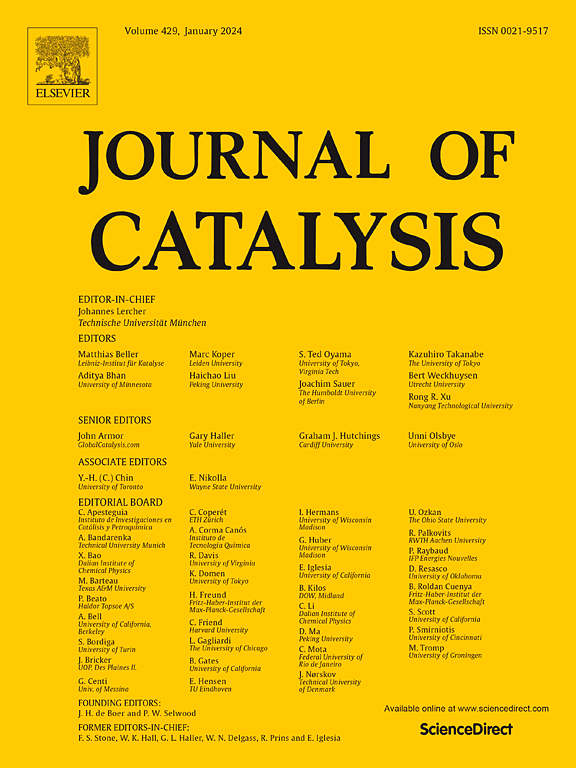聚多巴胺修饰电极表面氮化实现OER过程中的双吸附机制
IF 6.5
1区 化学
Q2 CHEMISTRY, PHYSICAL
引用次数: 0
摘要
确定析氧反应(OER)的速率仍然是水电解制氢的一个挑战。目前,人们认为催化剂的OER机理要么遵循吸附质演化机理(AEM)途径,要么遵循晶格氧氧化机理(LOM)途径。LOM驱动的催化剂可以直接形成O-O键,从而加速整个反应。然而,由于晶格氧的动态形成,不配位金属离子的浸出通常导致稳定性差。平衡LOM驱动催化剂的OER活性和稳定性仍然是一个挑战。本文通过聚多巴胺配位和一系列双金属氧化物前体(FeCo、FeNi、FeCu和CoCu)的氮化,构建了具有双吸附机制的催化剂电极(DAM)。在DAM驱动电极中,金属中心和晶格氧中心都参与了OER循环,形成了三角形的*O- m -*O键中间体,显著降低了OER过程的能垒,从而获得了优异的OER活性和稳定性。通过实验和理论计算验证了所提出的DAM机理。在电流密度为10/100 mA cm−2的情况下,FeCo基电极的过电位为194/253 mV,获得了优异的OER性能,并大大增强了耐用性。本文章由计算机程序翻译,如有差异,请以英文原文为准。


Dual adsorbate mechanism in OER process achieved by the surface nitridation of the polydopamine modified electrodes
The rate determining oxygen evolution reaction (OER) remains a challenge for hydrogen production through water electrolysis. Currently, OER mechanism of catalysts was regarded either following the adsorbate evolution mechanism (AEM) pathway, or the lattice oxygen oxidation mechanism (LOM) pathway. The LOM driven catalysts can directly form O-O bonds, thus accelerating the overall reaction. However, due to the dynamic formation of lattice oxygen, the leaching of uncoordinated metal ions usually leads to poor stability. Balancing the OER activity and stability in the LOM driven catalysts remained challenging. Herein, a catalyst electrode with emerged dual adsorbate mechanism (DAM) was constructed via the coordination of polydopamine and nitridation of a series of bimetallic oxides precursors (FeCo, FeNi, FeCu and CoCu). In the DAM driven electrode, both the metal center and lattice oxygen center participate in the OER cycles and formed the triangular *O-M-*O key intermediate, significantly reducing the energy barrier of the OER process, resulting in excellent OER activity and stability. The proposed DAM mechanism was verified by the experimental and theoretical calculation. Excellent OER performance was achieved in FeCo based electrodes with an over potential of 194/253 mV at a current density of 10/100 mA cm−2 with greatly enhanced durability.
求助全文
通过发布文献求助,成功后即可免费获取论文全文。
去求助
来源期刊

Journal of Catalysis
工程技术-工程:化工
CiteScore
12.30
自引率
5.50%
发文量
447
审稿时长
31 days
期刊介绍:
The Journal of Catalysis publishes scholarly articles on both heterogeneous and homogeneous catalysis, covering a wide range of chemical transformations. These include various types of catalysis, such as those mediated by photons, plasmons, and electrons. The focus of the studies is to understand the relationship between catalytic function and the underlying chemical properties of surfaces and metal complexes.
The articles in the journal offer innovative concepts and explore the synthesis and kinetics of inorganic solids and homogeneous complexes. Furthermore, they discuss spectroscopic techniques for characterizing catalysts, investigate the interaction of probes and reacting species with catalysts, and employ theoretical methods.
The research presented in the journal should have direct relevance to the field of catalytic processes, addressing either fundamental aspects or applications of catalysis.
 求助内容:
求助内容: 应助结果提醒方式:
应助结果提醒方式:


